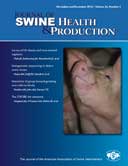Abstract:

Methods and processes of developing the Strengthening the Reporting of Observational Studies in Epidemiology – Veterinary (STROBE-Vet) statement
J. M. Sargeant, DVM, MSc, PhD; A. M. O’Connor, BVSc, MVSc, DVSc, FANZCVS (Epidemiology); I. R. Dohoo, DVM, PhD; H. N. Erb, DVM, PhD; M. Cevallos, MSc; M. Egger, MD, MSc, FFPH DTM&H; A. K. Ersbøll, MSc, PhD; S. W. Martin, DVM, MSc, MPVM, PhD, CAHS; L. R. Nielsen, DVM, PhD, DrVetSci; D. L. Pearl, DVM, MSc, PhD; D. U. Pfeiffer, Tierarzt, Dr med vet, PhD, DipECVPH; J. Sanchez, DVM, PhD; M. E. Torrence, DVM, PhD, DACVPM; H. Vigre, DVM, PhD; C. Waldner, DVM, PhD; M. P. Ward, BVSc (Hons), MSC, MPVM, PhD, DVSc, FACVSc
Complete article is available online.
PDF version is available online.
Background: Reporting of observational studies in veterinary research presents challenges that often are not addressed in published reporting guidelines.
Objective: To develop an extension of the STROBE (Strengthening the Reporting of Observational Studies in Epidemiology) statement that addresses unique reporting requirements for observational studies in veterinary medicine related to health, production, welfare, and food safety.
Design: Consensus meeting of experts.
Setting: Mississauga, Canada.
Participants: Seventeen experts from North America, Europe, and Australia.
Methods: Experts completed a pre-meeting survey about whether items in the STROBE statement should be added to or modified to address unique issues related to observational studies in animal species with health, production, welfare, or food-safety outcomes. During the meeting, each STROBE item was discussed to determine whether or not re-wording was recommended and whether additions were warranted. Anonymous voting was used to determine consensus.
Results: Six items required no modifications or additions. Modifications or additions were made to the STROBE items 1 (title and abstract), 3 (objectives), 5 (setting), 6 (participants), 7 (variables), 8 (data sources-measurement), 9 (bias), 10 (study size), 12 (statistical methods), 13 (participants), 14 (descriptive data), 15 (outcome data), 16 (main results), 17 (other analyses), 19 (limitations), and 22 (funding).
Conclusion: The methods and processes used were similar to those used for other extensions of the STROBE statement. The use of this STROBE statement extension should improve reporting of observational studies in veterinary research by recognizing unique features of observational studies involving food-producing and companion animals, products of animal origin, aquaculture, and wildlife.
Keywords: reporting guidelines, veterinary, observational study, animal
![]() Cite as: Sargeant JM, O’Connor AM, Dohoo IR, et al. Methods and processes of developing the Strengthening the Reporting of Observational Studies in Epidemiology – Veterinary (STROBE-Vet) statement. J Swine Health Prod 2016;24(6):315-325.
Cite as: Sargeant JM, O’Connor AM, Dohoo IR, et al. Methods and processes of developing the Strengthening the Reporting of Observational Studies in Epidemiology – Veterinary (STROBE-Vet) statement. J Swine Health Prod 2016;24(6):315-325.
Search the AASV web site for pages with similar keywords.
